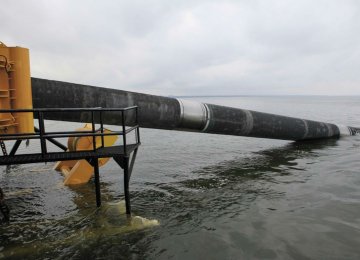Tehran and Muscat last week discussed a multi-billion-dollar project to export Iranian natural gas to the Arab country via a subsea pipeline through the Persian Gulf in a joint meeting with senior executives from the Royal Dutch Shell, French energy giant Total and Korea Gas Corporation (KOGAS).
Officials from the National Iranian Gas Export Company and Oman’s Ministry of Oil and Gas mulled over various scenarios to include Shell, Total and KOGAS in the subsea pipeline project in a meeting at NIGEC headquarters in Tehran at the weekend, IRNA reported.
In 2013, the two countries signed an agreement to supply Iranian gas to Oman through the pipeline in a deal that could be worth $60 billion over 25 years.
According to state news agency, the latest meeting did produce the desired results and negotiations will continue.
The lifting of international restrictions against Tehran in January gave fresh impetus to negotiations on the subsea pipeline project. Iran and Oman have increasingly sought to iron out the technical and financial details of the plan during the past few months.
The planned pipeline would connect Iran's vast gas reserves to Omani consumers as well as liquefied natural gas (LNG) plants in the sultanate for re-export.
In an interview with Reuters in August, Oman's Minister of Oil and Gas Mohammed bin Hamad al-Rumhy said his country and Iran were at an advanced stage of designing the pipeline and had agreed on a deeper option than originally envisaged to avoid crossing the UAE borders.
“Instead of the shallower option at around 300 meters deep, the pipeline could plunge close to 1,000 meters below the sea's surface and will be slightly shorter,” he said.
Experts say maintenance of the pipeline will be much more difficult at that depth.
Plans for Tender
Rumhy said Oman still expects to invite companies before the end of 2016 to bid for the engineering, procurement and construction parts of the project.
According to published reports, the pipeline would be financed on a 50-50 basis by Oman and Iran.
The two neighbors hope the pipeline would be commissioned two years after construction work begins. However, there are valid concerns that volatility in the oil/gas market in the past two years could undermine the multi-billion-dollar project.
“The pipeline would not be profitable in today's market environment,” al-Rumhy has been quoted as saying.
Alireza Kameli, NIGEC’s former managing director, told the Oil Ministry's news service Shana earlier that once the feasibility studies of the project are finalized, the two countries will announce a tender and select a contractor.
Iran and Oman are also considering plans to increase gas supply capacity of the pipeline from 28 million cubic meters per day to 42 mcm/d over 15 years.











Add new comment
Read our comment policy before posting your viewpoints